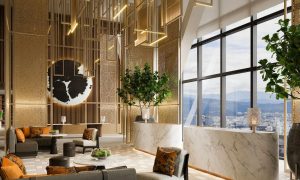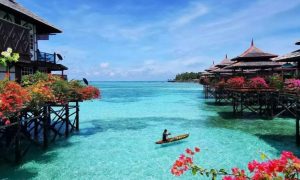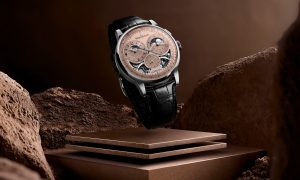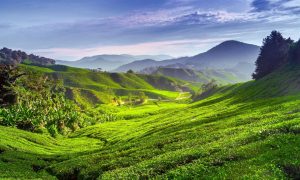This post was written by Anis Ramli
ANIS RAMLI TAKES A ROAD TRIP ON ONE OF THE OLDEST HIGHWAYS IN MALAYSIA TO DISCOVER THE OLD-WORLD CHARM OF TERENGGANU.
The deep seas off Terengganu may be rich in oil and gas reserves, but some argue that its real treasures are all found on the mainland. With a documented history reaching as far back as the 2nd century, Terengganu certainly has accumulated a wealth of heritage and, despite modern developments, the old Terengganu still remains. The best way to explore it? Via Federal Route 3. This highway may be approaching a hundred years old, but it remains one of Malaysia’s most scenic highways and a super way to enjoy the aesthetic delights of Terengganu.
HIT THE ROAD
Covering 739km, Route 3 runs alongside the coast of four Malaysian states – Johor, Pahang, Terengganu, and Kelantan – before it extends as part of the Asian Highway Network that connects Asia to the upper reaches of Europe.
It’s ironic that, 20 years after it was built by the British for economic reasons, Route 3 would ultimately bring about the fall of the Allied Forces, as in 1941 Japanese troops used it to swiftly advance south on bicycles during the Battle of Malaya.
Having served for economic and political purposes in the past, it must be said that Route 3 today is best suited for more leisurely pursuits, and the relatively flat and straight road provides an easy, scenic drive.
Travelling northwards, the glittering South China Sea is your constant companion (distraction) to the east, and some sections of the highway run alongside lush pockets of mangrove forests along the coastal estuaries.
There’s no escaping the countryside charm of Terengganu, even as the bigger towns try to shed the pastoral image with concrete buildings and foreign franchise retailers. Fishing villages located on the outskirts of towns speak of the population’s time-honoured source of income. Fishermen bring their boats ashore on public beaches, while many of the wooden homes here are still built on stilts in a compound of coconut trees.
Even the stretch of road from Kerteh to Paka – where Malaysia’s oil and gas refinery activities are based – makes for excellent night driving. As the sun sets, the huge complex of pipes, steel tanks, smoke stacks, and gas flutes lights up as spectacularly as a space station.
CHUKAI
A great way to get to know Terengganu is through its food, and there is no better place to start than in Chukai (in the district of Kemaman), which is among the first towns you encounter along the Terengganu section of Route 3 northwards. Kim Wah (also known as Kin To Wah) Restaurant is a spartan corner establishment on Jalan Masjid with an even simpler menu, selling nothing but chicken rice.
One of the enduring legacies of the Chinese community in Malaysia is the kopitiam. These old-style cafés are famous for their Asian-style coffee and charcoal-toasted bread generously slathered with butter and kaya (coconut jam). Kemaman’s very own kopitiam – Hai Peng Kopitiam on Jalan Sulaimani – has been enjoying a good reputation since the 1930s. Besides the toast, their other specialty is the typical Terengganu dish nasi dagang – beautifully steamed rice with a serving of rich tuna curry wrapped in banana leaf parcels.
In the evening, join the locals at Pantai Geliga beach for traditional East Coast teatime treats of satar (fish cakes wrapped in banana leaves and grilled), keropok lekor (fish crackers) and sotong celup tepung (deep fried squid).
KUALA DUNGUN
About an hour’s drive north of Chukai is Kuala Dungun, a town that once enjoyed the wealth of its iron ore mining activities. Nothing much of its glorious past remains except for the nondescript concrete pillar in the sea that some say was part of the railway line that transported iron from Bukit Besi to Kuala Dungun. About 30km inland, in Bukit Besi, are a few more of these legacies are evident, including the stockpile buildings, tunnels, and chimneys used during the tin-mining days and left behind by the Japanese, who first discovered the riches within the area.
Seemingly bereft of any tourist attractions, Kuala Dungun would be an unlikely stop for those passing through Terengganu if not for the Tanjong Jara Resort. Despite its modest kampung location, the resort (part of the YTL luxury property chain) has gained a worldwide reputation for its unique architecture and welcome.
The district of Dungun, especially the beaches at Rantau Abang, used to be the calling place of giant leatherback turtles who returned yearly to the beaches to lay their eggs. In the 1970s, as many as 1,000 leatherback landings were reported, but sadly these nesting giants are a rare sight these days due to modern developments and human interference. However, it is still possible to view green turtle landings in other parts of Dungun.
Complement the turtle viewing experience with a trip to the Turtle Information Centre in Rantau Abang, just 15km north of the Tanjong Jara Resort, to learn more about them.
KUALA TERENGGANU
After the tranquil panoramas of Kemaman, Dungun, and Marang, the bustle of state capital Kuala Terengganu takes a while to get used to. Pasar Payang is the central market where all manner of trade is conducted, and it would almost be a sin to leave town without at least purchasing the signature East Coast fabric, batik, or indulging in the Terengganu brocade – a textile of royal origins made using fine gold and silk threads.
Spend a quick afternoon on the Terengganu River Cruise (leaving from the Islamic Civilisation Park jetty) to learn about the history and development of the area, before hopping over to Pulau Duyong to walk within the walls of an old fortress. Built in the 1920s, Kota Lama Duyong is a traditional Terengganu house with Greek Corinthian elements in its columns and Islamic influences in the decorative wood carvings.
PENARIK
Continue northwards from Kuala Terengganu and you will reach Penarik in the district of Setiu. This serene fishing village has a unique geographical landscape and is the setting of Terrapuri Heritage Village. Part conservation project, part boutique guest house, this is an on-going 20-year labour of love by local entrepreneur, Alex Lee, to preserve the authentic traditions of the Malay Terengganu house. Guests here are accommodated in one of 29 century-old dwellings, each one personally sourced by Lee from various parts of Terengganu, dismantled, carefully restored and assembled again on this piece of beach-front land in Kampung Mangkuk.
BEACHES
With a coastline that runs for 244km, Terengganu’s beaches are some of the best in the country.
Teluk Bidara in Dungun is a bay near Tanjong Jara Resort where one can explore the cave and lighthouse on Tanjung Api Hill at low tide. Kuala Abang and Kemasik beaches have some interesting sea-side rock formations on which to perch and enjoy the miles of blue, while Penarik tears you in two with the river wetlands on one side and gorgeous beach on the other.
The long Terengganu coastline may look inviting, but beware of the strong undercurrents in certain places.
This article is courtesy of Tourism Malaysia; www.tourism.gov.my
———————————————————————————————————
When to go:
Terengganu experiences heavier rainfall and flooding in certain areas during the monsoon season between November and January. Trips to the islands are not advised during this period due to uncertain sea conditions. However, monsoon season is considered low season, so travellers get better deals on hotels.
How to Get There:
Kuala Lumpur to Kuala Terengganu (455km): Take the Karak Highway, then the East Coast Expressway, and exit at Jabor toll. Continue towards Kuala Terengganu on Federal Route 3.
Singapore/Johor Bahru to Kuala Terengganu (562km): Take Federal Route 3 to Kota Tinggi, Mersing, Kuala Rompin, Pekan, Kuantan and Kuala Terengganu.
Penang to Kuala Terengganu (460km): Take Federal Route 4 via Grik to Jertih, then turn into Federal Route 3 to Kuala Terengganu.
Fly to Kuala Terengganu Airport from Kuala Lumpur International Airport (KLIA) on Malaysia Airlines or AirAsia; or from Subang Airport (Kuala Lumpur) on Firefly.
———————————————————————————————————
Source: Senses of Malaysia Nov-Dec 2012
Read more:
- A Slow Boat Ride to Langkawi
- The Island of Koh Lipe
- Dewa Phuket: A Private and Luxurious Accommodation in Phuket
Have thoughts or comments on this article? Let us know by posting your comments below
















